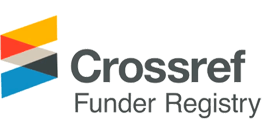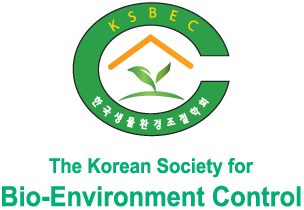-
Original Articles

-
Tea Leaf Disease Classification Using Artificial Intelligence (AI) Models
인공지능(AI) 모델을 사용한 차나무 잎의 병해 분류
-
K.P.S. Kumaratenna, Young-Yeol Cho
피우미 사우미야 쿠마라테나, 조영열
- In this study, five artificial intelligence (AI) models: Inception v3, SqueezeNet (local), VGG-16, Painters, and DeepLoc were used to classify tea leaf …
이 연구에서는 Inception V3, SqueezeNet(local), VGG-16, Painters 및 DeepLoc의 다섯 가지 인공지능(AI) 모델을 사용하여 차나무 잎의 병해를 분류하였다. 여덟 가지 이미지 카테고리를 …
- In this study, five artificial intelligence (AI) models: Inception v3, SqueezeNet (local), VGG-16, Painters, and DeepLoc were used to classify tea leaf diseases. Eight image categories were used: healthy, algal leaf spot, anthracnose, bird’s eye spot, brown blight, gray blight, red leaf spot, and white spot. Software used in this study was Orange 3 which functions as a Python library for visual programming, that operates through an interface that generates workflows to visually manipulate and analyze the data. The precision of each AI model was recorded to select the ideal AI model. All models were trained using the Adam solver, rectified linear unit activation function, 100 neurons in the hidden layers, 200 maximum number of iterations in the neural network, and 0.0001 regularizations. To extend the functionality of Orange 3, new add-ons can be installed and, this study image analytics add-on was newly added which is required for image analysis. For the training model, the import image, image embedding, neural network, test and score, and confusion matrix widgets were used, whereas the import images, image embedding, predictions, and image viewer widgets were used for the prediction. Precisions of the neural networks of the five AI models (Inception v3, SqueezeNet (local), VGG-16, Painters, and DeepLoc) were 0.807, 0.901, 0.780, 0.800, and 0.771, respectively. Finally, the SqueezeNet (local) model was selected as the optimal AI model for the detection of tea diseases using tea leaf images owing to its high precision and good performance throughout the confusion matrix.
- COLLAPSE
이 연구에서는 Inception V3, SqueezeNet(local), VGG-16, Painters 및 DeepLoc의 다섯 가지 인공지능(AI) 모델을 사용하여 차나무 잎의 병해를 분류하였다. 여덟 가지 이미지 카테고리를 사용하였는데, healthy, algal leaf spot, anthracnose, bird’s eye spot, brown blight, gray blight, red leaf spot, and white spot였다. 이 연구에서 사용한 소프트웨어는 데이터 시각적 프로그래밍을 위한 파이썬 라이브러리로 작동하는 Orange3였다. 이는 데이터를 시각적으로 조작하여 분석하기 위한 워크플로를 생성하는 인터페이스를 통해 작동되었다. 각 AI 모델의 정확도로 최적의 AI 모델을 선택하였다. 모든 모델은 Adam 최적화, ReLU 활성화 함수, 은닉 레이어에 100개의 뉴런, 신경망의 최대 반복 횟수가 200회, 그리고 0.0001 정규화를 사용하여 훈련되었다. Orange3 기능을 확장하기 위해 새로운 이미지 분석 Add-on을 설치하였다. 훈련 모델에서는 이미지 가져오기(import image), 이미지 임베딩(image embedding), 신경망(neural network), 테스트 및 점수(test and score), 혼동 행렬(confusion matrix) 위젯이 사용되었으며, 예측에는 이미지 가져오기(import image), 이미지 임베딩(image embedding), 예측(prediction) 및 이미지 뷰어(image viewer) 위젯이 사용되었다. 다섯 AI 모델[Inception V3, SqueezeNet(로컬), VGG-16, Painters 및 DeepLoc]의 신경망 정밀도는 각각 0.807, 0.901, 0.780, 0.800 및 0.771이었다. 결론적으로 SqueezeNet(local) 모델이 차나무 잎 이미지를 사용하여 차 병해 탐색을 위한 최적 AI 모델로 선택되었으며, 정확도와 혼동 행렬을 통해 뛰어난 성능을 보였다.
-
Tea Leaf Disease Classification Using Artificial Intelligence (AI) Models
-
Original Articles

-
The Effect of Gibberellin Dipping Concentration and Treatment Time on the Growth of Cutting Propagules in Strawberry
딸기 삽목 육묘 시 묘 생육에 미치는 지베렐린 침지농도 및 시간의 영향
-
Eun Ji Kim, Chi Seon Kim, Hyun Soo Jung, Jun Gu Lee
김은지, 김치선, 정현수, 이준구
- The aim of this research was to investigate the effect of gibberellin on improving seedling growth characteristics and enhancing strawberry quality in …
본 연구는 딸기의 삽목 육묘 시 묘소질을 향상시키고 품질을 증진시키기 위한 지베렐린 효과를 검증하기 위해 수행되었다. 품종은 ‘설향’을 대상으로 하였고, 삽목 시 …
- The aim of this research was to investigate the effect of gibberellin on improving seedling growth characteristics and enhancing strawberry quality in cutting propagation. Cuttings of the cultivar ‘Seolhyang’ were treated with GA3 for 30 and 60 minutes at concentrations of 50, 100, and 150 mg·L-1, with distilled water used for dipping as the control. Evaluation of seedling growth showed a positive correlation between the duration of gibberellin dipping and growth characteristics such as leaf number and SPAD value. Plant height, petiole length, leaf length and width, and leaf area varied significantly based on the interaction between dipping time and concentration. Crown diameter exhibited differences depending on the dipping time, with cuttings producing superior seedlings having a diameter of 8.0 mm or more for all treatments except the 30-minute, 100 mg·L-1 treatment. The T/R ratio was significantly lower in the 30-minute, 50 mg·L-1 treatment, indicating the highest plant vigor. Quantum yield was lower at a concentration of 150 mg·L-1, showing a decreasing trend with increasing gibberellin concentration. Nonphotochemical quenching was significantly smaller in the 30-minute, 150 mg·L-1 treatment, indicating an effective reduction of stress in the cuttings. Antioxidant content was highest in the 30-minute, 50 mg·L-1 treatment and the 60-minute, 150 mg·L-1 treatment. Moreover, the results of post-transplanting growth assessment showed no negative effect of gibberellin on flowering induction. Therefore, it was confirmed that gibberellin treatment during the cutting propagation of ‘Seolhyang’ strawberries had a positive effect on the production of high-quality seedlings. Dipping the cuttings in 50 mg·L-1 gibberellin for 30 minutes is considered to be the most suitable method for improving growth and quality compared to the control.
- COLLAPSE
본 연구는 딸기의 삽목 육묘 시 묘소질을 향상시키고 품질을 증진시키기 위한 지베렐린 효과를 검증하기 위해 수행되었다. 품종은 ‘설향’을 대상으로 하였고, 삽목 시 삽수의 기부를 30, 60분간 GA3 50, 100, 150mg·L-1에 침지 처리하고 증류수 침지를 대조구로 두었다. 정식 시 묘소질 조사 결과 엽수와 SPAD 값은 지베렐린 침지시간이 길수록 증가하였고, 초장, 엽병장, 엽장, 엽폭, 엽면적은 침지시간과 농도 간의 상호작용에 따라 유의하게 값이 변하였다. 관부직경은 같은 농도라 할지라도 침지시간에 따른 차이가 나타났으며 30분, 100mg·L-1 처리를 제외하고 모두 직경이 8.0mm 이상으로 우량한 묘가 생성되었으며, T/R률은 30분, 50mg·L-1 처리에서 유의하게 작아 식물체 활력이 가장 우수했다. 양자수율은 농도가 150mg·L-1일 때 저조하였고, 지베렐린 처리 농도가 높을수록 양자수율이 감소하는 경향을 나타냈다. NPQ는 대조구 대비 30분, 150mg·L-1 처리에서 유의하게 작아 묘 스트레스 감소에 효과가 있었다. 항산화물 함량은 30분, 50mg·L-1 처리와 60분, 150mg·L-1 처리에서 높게 나타났고, 정식 후 생육조사 결과 화아분화 정도에 미치는 지베렐린의 부정적 영향은 없었다. 따라서, ‘설향’ 딸기의 삽목 육묘 시 지베렐린 처리는 정식묘 양성에 효과가 있는 것을 확인할 수 있었으며, 이때 대조구 대비 생육 증진 및 품질 향상을 위해서는 삽수 기부를 50mg·L-1의 지베렐린에 30분 침지처리하는 것이 보다 적정한 것으로 판단되었다.
-
The Effect of Gibberellin Dipping Concentration and Treatment Time on the Growth of Cutting Propagules in Strawberry
-
Original Articles

-
Comparison with Growth Characteristics of Korean Melon (Cucumis melo var. makuwa) Grafted Seedlings in a Container Type Farm with LED Light and a Greenhouse under High Temperature Conditions
인공광 기반 컨테이너 육묘 시스템과 고온 조건의 플라스틱 온실 육묘에서 참외 접목묘 생육 특성 비교
-
Wook Jin Song, Hee Woong Goo, Gyu Won Lee, Hyun Mun Kim, Kyoung Sub Park
송욱진, 구희웅, 이규원, 김현문, 박경섭
- This study was carried out to analyze the growth of grafted seedlings produced in a container-type farm system and a greenhouse to …
본 연구의 목적은 컨테이너 육묘 시스템을 활용한 참외 접목묘의 안정적인 생산 가능성을 평가하는 것이었다. 이를 위해, 컨테이너 육묘 시스템과 고온 조건의 플라스틱 …
- This study was carried out to analyze the growth of grafted seedlings produced in a container-type farm system and a greenhouse to stably produce high-quality seedlings. For 14 days after graft-taking, the characteristics of korean melon grafted seedlings were compared by container farm and greenhouse. The container seedling system maintained a stable day/night temperature (25/20°C), relative humidity (70%), and light environment (PPFD 200µmol·m-2·s-1, photoperiod (16/8h). The difference between day and night temperature (DIF) was relatively large, with a mean temperature of 28.1/15.4°C in the high-temperature greenhouse. Plant height of the korean melon seedling was longer in the greenhouse than in the closed seedling system, and the average SPAD value was 30.5 and 41.1 in the greenhouse and closed seedling system, respectively. To calculate the compactness of the graft seedlings, the shoot dry weight was divided by the plant height, and the value was 44.9±2.64 mg/cm and 24.4±1.56 mg/cm in the closed seedling system and the greenhouse treatment, respectively, 7 days after graft-taking. To produce high-quality seedlings during high-temperature or low-photo periods, it will be necessary to analyze the key factors that affect growth characteristics and transplanting growth and to verify the effects of the closed seedling system based on post-transplanting growth and yield.
- COLLAPSE
본 연구의 목적은 컨테이너 육묘 시스템을 활용한 참외 접목묘의 안정적인 생산 가능성을 평가하는 것이었다. 이를 위해, 컨테이너 육묘 시스템과 고온 조건의 플라스틱 온실에서 육묘한 접수와 대목, 접목묘의 생육을 비교 분석하였다. 접목활착 후 육묘 환경에 따른 참외 접목묘의 생육과 묘소질을 0일, 4일, 7일, 11일, 14일째에 비교하였다. 컨테이너 육묘 시스템에서는 주야간 온도를 25/20°C, 상대습도를 70%로 설정하여 재배기간 동안 안정적으로 유지하였으며, 플라스틱 온실 내의 주야간 평균온도는 28.1/15.4°C로 주야간 온도차(DIF)가 더 크게 나타났다. 조사기간 동안 참외 접목묘의 초장은 플라스틱 온실 육묘 처리구에서 컨테이너 육묘 시스템 처리구보다 더 길게 나타났다. 참외 접목묘 조직의 충실도는 지상부 건물중을 초장으로 나누어 계산하였다. 육묘장에서 접목한 묘는 접목 후 7-10일 경과하여 활착이 완료되고 초장이 10cm 내외일 때 출하하여 정식에 이용되게 된다. 본 연구에서 접목활착 후 7일째에 컨테이너 육묘 시스템에서 재배된 묘의 충실도는 44.9±2.64mg/cm으로 나타났으며, 플라스틱 온실 육묘 처리구에서는 24.4±1.56mg/cm로 나타났다. SPAD 평균은 플라스틱 온실 육묘에서 30.5, 컨테이너 육묘 시스템에서 41.1로 측정되었다. 이러한 결과는 컨테이너 육묘 시스템의 활용이 고온기 또는 저일조 시기와 같은 육묘 환경에서도 고품질 모종을 안정적으로 생산할 수 있는 것을 확인하였고, 인공광을 이용한 육묘 시스템의 활용 범위가 앞으로 더 확대될 것으로 기대된다.
-
Comparison with Growth Characteristics of Korean Melon (Cucumis melo var. makuwa) Grafted Seedlings in a Container Type Farm with LED Light and a Greenhouse under High Temperature Conditions
-
Original Articles

-
Appropriate Working Period and Storage Characteristics Based on Residual Leaf Length of Onion (Allium cepa L.) Harvested with a Blower-type Stem Cutter
송풍식 줄기절단기에 의한 적정 양파 잎 절단 시기 및 잔여 엽장에 따른 양파 저장 특성
-
Byeonggyu Min, Jiyoung Son, Mijin Lee, Jinseong Moon, Juhee Baek, Jaecheol Seo, Jungho Shin, Seunggwi Kwon, Soonjung Hong, Sanghee Lee
민병규, 손지영, 이미진, 문진성, 백주희, 서재철, 신정호, 권승귀, 홍순중, 이상희
- This study was conducted to determine the optimal working conditions when a recently developed blower-type onion stem cutter is utilized for cutting …
최근 국내에서 개발된 송풍식 양파 줄기절단기를 수확기 양파 엽 절단에 활용할 경우 적정 작업 조건을 구명하기 위해서 이 실험을 수행하였다. 처리구 중 …
- This study was conducted to determine the optimal working conditions when a recently developed blower-type onion stem cutter is utilized for cutting onion leaves at harvest time. The June 20 leaf cutting treatment group had the highest leaf dryness among the treatment groups (leaf dryness: 66.3%; leaf moisture content: 50.5%); the residual leaf length was 6.7 ± 3.5 cm. It is considered to have the best mechanical leaf cutting performance among the treatment groups because it is included in the optimal range of 4–10 cm. The average working speed of mechanical onion leaf cutting using the stem cutter was 0.17 m·s-1, which is approximately 3.4 times faster than the average working speed of 0.05 m·s-1 in the human leaf cutting treatment group. This is expected to save approximately 2.6 hours compared to human labor (based on one person) when working on a 10a area using this machine. In addition, the incidence of damaged bulbs in the machine leaf cutting treatment group was 1.3%, compared to 0.0% in the manual leaf cutting treatment group. This suggests that the mechanical leaf cutting treatment group had a higher average onion bulb decay rate during storage than the manual leaf cutting treatment group. When the storage characteristics of each treatment group were examined, the decay rate by bulb part (leaf connected or root connected) after 8 months of storage was higher in the treatment group with a residual leaf length of less than 5.0 cm after mechanical leaf cutting than in the treatment with a residual leaf length of more than 5.0 cm. This is thought to be due to the fact that treatments with a residual leaf length of less than 5.0 cm are more susceptible to infection by pathogens that cause decay during storage than treatments with a residual leaf length of 5.0 cm or more. Based on the results of this experiment, performance target of the experimental machine (residual leaf length after operation: 5 cm), and existing research on the optimal residual leaf length for onion harvesting, it is recommended to cut onion leaves so that the residual leaf length is 5–10 cm when using the stem cutter.
- COLLAPSE
최근 국내에서 개발된 송풍식 양파 줄기절단기를 수확기 양파 엽 절단에 활용할 경우 적정 작업 조건을 구명하기 위해서 이 실험을 수행하였다. 처리구 중 식물체 엽 건조가 가장 많이 진행된(엽 건조 정도 : 66.3%, 엽 수분함량 : 50.5%) 6월 20일 엽 절단 처리구에서 평균 잔여 엽장은 6.7±3.5cm로서 작업 후 적정 잔여 엽장에 해당되는 범위인 4-10cm에 포함되므로 기계 엽 절단 성능이 처리구 중 가장 우수한 것으로 판단된다. 줄기절단기 이용 양파 엽 기계 절단 시 평균 작업 속도는 0.17m·s-1였는데, 이는 인력 엽 절단 처리구의 평균 작업 속도인 0.05m·s-1보다 3.4배 정도 빨랐으며, 이를 통해 해당 기종을 이용하여 10a 면적을 작업할 경우에는 인력 작업(1인 기준)에 비해 2.6시간 정도를 절감할 수 있을 것으로 기대된다. 또한 기계 엽 절단 처리구에서의 손상구 발생률은 1.3%로서 인력 엽 절단 처리구의 0.0%에 비해 높았는데, 이로 인해 기계 엽 절단 처리구가 인력 엽 절단 처리구보다 저장 중 양파 구 부패율이 평균적으로 높았던 것으로 판단된다. 처리별 저장 특성을 살펴보면, 저장 8개월 후 구 부위(기부, 정부)별 부패율은 기계 엽 절단 후 잔여 엽장이 5.0cm 미만인 처리구에서 잔여 엽장이 5.0cm 이상인 처리구보다 높았다. 이는 잔여 엽 길이가 5.0cm 미만인 처리구에서는 5.0cm 이상인 처리구보다 저장 중 구 부패를 유발하는 병원균의 감염이 쉬우므로 장기 저장 시 부패율이 높은 것으로 생각된다. 본 실험 결과와 실험 기종의 성능 목표(작업 후 잔여 엽장 : 5cm) 및 양파 수확 시 적정 잔여 엽장에 관한 기존의 연구결과 등을 종합적으로 고려할 경우, 본 실험에 사용된 줄기절단기 이용 양파 엽 절단 시 양파의 적정 잔여 엽장은 5-10cm 정도일 것으로 판단된다.
-
Appropriate Working Period and Storage Characteristics Based on Residual Leaf Length of Onion (Allium cepa L.) Harvested with a Blower-type Stem Cutter
-
Original Articles

-
Growth and Fruit Characteristics according to Filling and Planting Methods of Coir Medium Hydroponically Grown Cucumber
코이어 배지의 포수 및 정식 방법에 따른 수경재배 오이의 생육 및 과실 특성
-
Heung Soo Lee, Hyo Jun Bae, Jong Hyang Bae, Baul Ko
이흥수, 배효준, 배종향, 고바울
- This study was conducted to validate the growth and productivity of cucumber hydroponics using coir as the medium, different types of nutrient …
본 연구는 코이어 배지를 이용한 오이 수경재배에서 배지 포수액의 종류와 정식 방법에 따른 생육 및 생산성을 검증하여 가장 효율성이 높은 재배 방법의 …
- This study was conducted to validate the growth and productivity of cucumber hydroponics using coir as the medium, different types of nutrient solutions and formal methods, in order to select the most efficient cultivation method. The nutrient solutions consisted of culture solution (S) and raw water (W), the planting methods were rockwool cube seedlings (RC), rockwool plug seedlings (RP), and slab directly seedlings (DS). The reference date was set the sowing date. The initial growth showed a significant increase in the culture solution treatment, the differences among treatments decreased as the growth period lengthened. There was no apparent correlation between the planting methods and growth, but different results were observed among the same planting methods depending on nutrient solution used. Similarly, productivity followed a similar trend, with significantly higher harvest in the culture solution treatment during the initial harvest period of 6-8 weeks after sowing, but the harvest gap among treatments were diminished in the after period. The cumulative harvest was significantly higher in the culture solution treatment due to the initial difference in harvest quantity. Plant growth and fruit productivity exhibited a similar trend, showing a linear relationship. There was no correlation among the planting methods, but direct seedling with the culture solution showed the highest initial growth and harvests due to stable nutrient and moisture supply in the initial root zone. Therefore, it is believed that direct seeding method on the culture solution medium would be most advantageous for plant growth and productivity. Additionally, it is expected to contribute to cost effectiveness from an economic perspective through simplification of the cultivation process, labor costs and production cost reduction.
- COLLAPSE
본 연구는 코이어 배지를 이용한 오이 수경재배에서 배지 포수액의 종류와 정식 방법에 따른 생육 및 생산성을 검증하여 가장 효율성이 높은 재배 방법의 선발을 위하여 수행되었다. 포수액은 배양액(S)과 원수(W), 육묘는 암면큐브 육묘(RC), 암면 플러그묘(RP), 슬라브 직파(DS)로 하였다. 재배 기간을 동일하게 하기 위하여 기준일은 파종일로 하였다. 초기 생육량은 S 처리에 서 유의하게 높았으나, 생육기간이 길어질수록 처리 간 차이가 감소하였다. 정식 방법과 생육량 간에는 관계성이 나타나지 않았으나, 포수 방법에 따라 동일한 정식방법 간에도 다른 결과가 나타났다. 생산성도 동일한 경향으로 초기 수확기인 파종 후 6-8주까지는 S 처리에서 수확과의 수가 유의하게 많았으며, 이후 동일한 기간 수량의 격차가 해소되었다. 누적 수량은 초기 수확량의 차이로 인하여 S 처리에서 유의하게 높았다. 식물체의 생육과 과실 생산성은 유사한 경향으로 선형적인 관계성을 나타내었다. 정식 방법 간에는 상관성을 나타내지 않았으나, S의 DS 처리가 초기 근권부 안정적인 양·수분 공급으로 초기 생육 및 수량이 가장 많은 경향이었다. 따라서 S 처리한 배지에 DS 방식이 식물체의 생육 및 생산성에 가장 유리할 뿐만 아니라 재배단계 간소화를 통한 노동력 및 생산 원가 절감으로 경제성 측면에서도 기여할 수 있을 것으로 생각된다.
-
Growth and Fruit Characteristics according to Filling and Planting Methods of Coir Medium Hydroponically Grown Cucumber
-
Original Articles
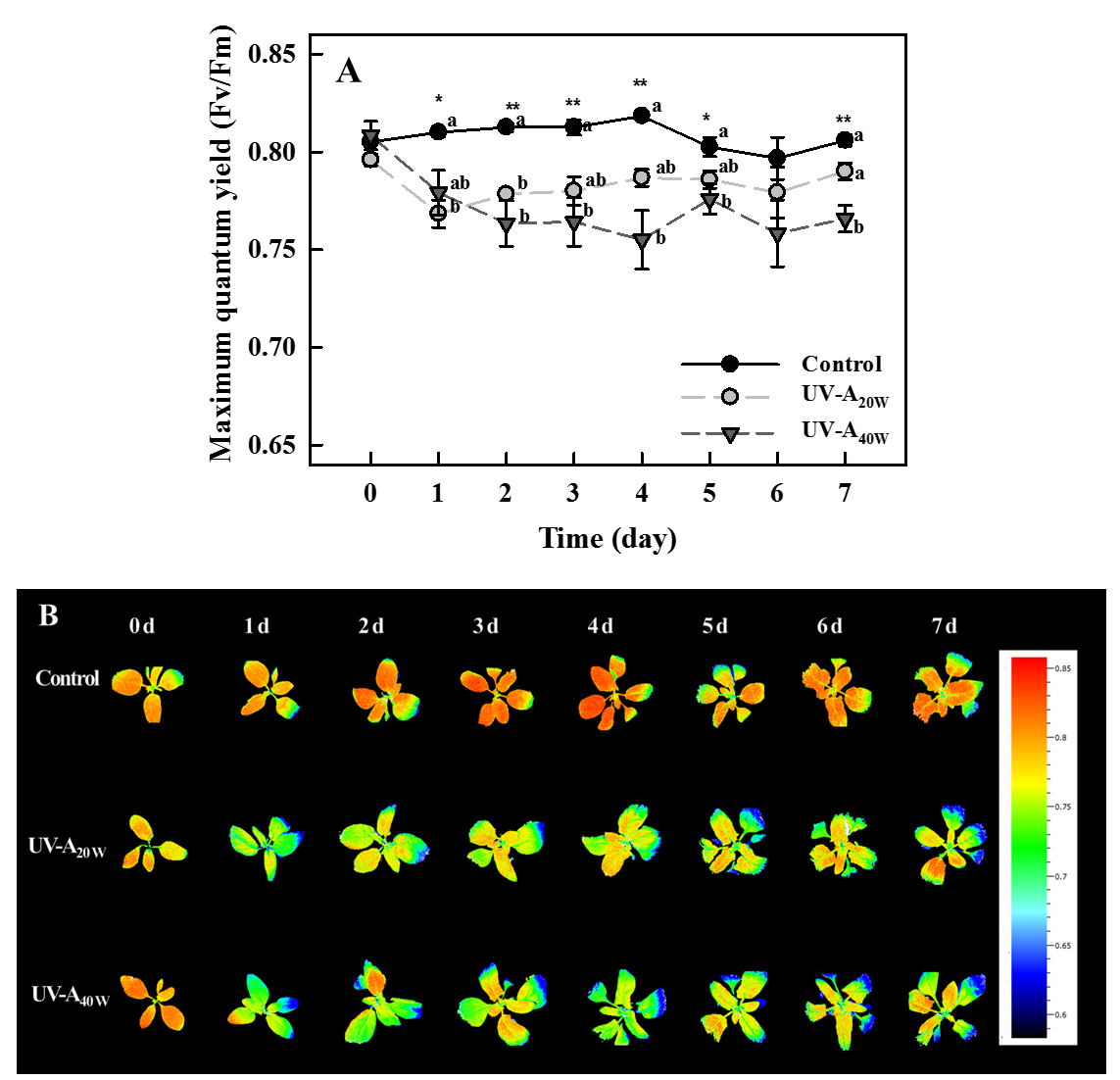
-
Effects of Supplemental UV-A LED Radiation on Growth and Bioactive Compounds in Spinach
시금치에서 생장 및 생리활성물질에 대한 UV-A LED의 보광 효과
-
Da-Seul Choi, Jin-Hui Lee, Myung-Min Oh
최다슬, 이진희, 오명민
- A proper level of UV-A light treatment in terms of intensity, spectrum, and exposure duration is known to have a positive impact …
본 연구에서는 단기간의 UV-A 조사가 시금치(Spinacia oleracea L.)의 생장과 생리활성물질에 미치는 영향을 평가하였다. 시금치 묘는 200µmol·m-2·s-1 PPFD, white …
- A proper level of UV-A light treatment in terms of intensity, spectrum, and exposure duration is known to have a positive impact on plant growth, photosynthesis, and the biosynthesis of secondary metabolites. However, there are few studies investigating the physiological responses of spinach (Spinacia oleracea L.) to UV radiation. Hence, this study aimed to assess the effects of short-term UV-A radiation on the growth and bioactive compounds of spinach. Spinach seedlings were cultivated in a vertical farm module under the following environmental conditions: photosynthetic photon flux density 200 µmol·m-2·s-1, white LED, 12 h on/off, 20°C air temperature, 70% relative humidity, and 500 µmol·mol-1 CO2 concentration. After 5 weeks of sowing, the seedlings were subjected to continuous UV-A (peak wavelength; 385 nm) irradiation at two different energy levels: 20 W·m-2 and 40 W·m-2 for 7 days. As a result, the UV-A20W treatment increased the shoot fresh and dry weights of spinach. However, there were no significant differences observed in photosynthetic parameters between the UV-A treatments and the control. The maximum quantum efficiency of photosystem II (Fv/Fm) consistently decreased across all UV-A treatments for 7 days in UV-A treatments. Additionally, the total phenolic content and antioxidant capacity increased in the UV-A20W treatment at 7 days of treatment as well as the total flavonoid content significantly increased at 5 and 7 days of treatment. These findings suggest that supplemental UV-A LED radiation can enhance the growth and quality of spinach cultivated in closed type plant production systems such as vertical farms.
- COLLAPSE
본 연구에서는 단기간의 UV-A 조사가 시금치(Spinacia oleracea L.)의 생장과 생리활성물질에 미치는 영향을 평가하였다. 시금치 묘는 200µmol·m-2·s-1 PPFD, white LED, 광주기 12시간, 온도 20°C, 상대습도 70%, 이산화탄소 농도 500µmol·mol-1의 수직농장 모듈에서 재배되었다. 파종 후 5주된 묘는 7일 동안 20W·m-2와 40W·m-2의 두 가지 에너지 수준에서 연속적으로 UV-A(피크파장: 385nm) 조사한 후 생육 특성, 광합성 파라미터, 이미지 형광, 총 페놀 함량, 항산화도, 그리고 총 플라보노이드 함량을 분석하였다. 결과적으로, UV-A20W 처리는 시금치의 생체중과 건물중을 증가시켰다. 하지만, UV-A 처리구와 대조구 사이의 광합성 파라미터에는 유의한 차이가 나타나지 않았다. 광계Ⅱ의 최대양자수율(Fv/Fm)은 모든 UV-A 처리에서 7일동안 지속적으로 감소했다. 또한, UV-A20W 처리에서 식물체당 총 페놀 함량과 항산화도는 처리 7일째 증대되었으며, 총 플라보노이드 함량은 처리 5일째부터 유의적으로 증가하였다. 이러한 결과는 UV-A LED 보광이 수직농장과 같은 폐쇄형 식물 생산 시스템에서 재배되는 시금치의 생장과 품질을 향상시킬 수 있음을 시사한다.
-
Effects of Supplemental UV-A LED Radiation on Growth and Bioactive Compounds in Spinach
-
Original Articles

-
Nutrient Uptake Rate, Growth and Yield of Strawberry in Aquaponics
아쿠아포닉스 재배에서 딸기의 양분흡수율, 생육 및 수량
-
Min-Kyung Kim, Su-Hyun Choi, Seo-A Yoon, Jong-Nam Lee, Eun-Young Choi
김민경, 최수현, 윤서아, 이종남, 최은영
- This study aimed to compare the nutrient uptake rate, growth and yield of strawberry grown under the aquaponic and hydroponic systems in …
본 연구는 식물공장에서 아쿠아포닉스와 수경재배에서 재배된 딸기의 무기양분 흡수율, 생육, 수량을 비교하고자 수행되었다. 양어는 비단잉어(Cyprinus carpio) 12마리를 수조(W 0.7m × …
- This study aimed to compare the nutrient uptake rate, growth and yield of strawberry grown under the aquaponic and hydroponic systems in a plant factory. For aquaculture, 12 of fish (Cyprinus carpio cv. Koi) were raised in an aquaponics tank (W 0.7 m × L 1.5 m × H 0.45 m, 472.5 L) filled with 367.5L of water at a density of 5.44 kg·m-3. The 30 seedlings of strawberry were planted in ports filled with perlite substrate and then were placed on the bed (W 0.7 m × L 1.5 m × H 0.22 m) at the top of the aquaponics system, and the 30 seedlings were planted in net-pots and then placed on the holes of acrylic plates (140 cm × 60 cm, Ø80 mm) on the bed (W 0.7 m × L 1.5 m × H 0.22 m) at the deep flow technique (DFT)- hydroponics. The pH and EC of the aquaponic solution was ranged from 4.3 to 6.9 and 0.32 to 1.14 dS·m-1, respectively, while those of hydroponics were ranged from 5.1 to 7.5 and 1.0‒1.8 dS·m-1, respectively. The NO3-N and NH4-N concentration of the aquaponic solution were higher about 3.6 and 2.2 me·L-1 than those of the standard hydroponic solution for strawberry cultivation. The P, Ca, Mg, and S ions in the aquaponic solution were also higher about 0.76, 3.1, 0.8, and 0.9 me·L-1 than those of standard hydroponic solution, respectively, while the K and Fe were lower about 0.8 me·L-1 and 0.5 mg·L-1, respectively. The mineral contents of the strawberry leaves grown on aquaponics did not differ from that of hydroponics, and K content in the leaves were in an appropriate range. Uptake rates of T-N and P between the 58 and 98 days after transplant (DAT) were 1.5 and 1.9-fold higher in the aquaponics than those of hydroponics, respectively with no significant difference in the uptake rate of K. The crown diameter, plant height, and leaf length and width in the 98 DAT were significantly higher in aquaponics. The number of fruits per plant was significantly higher in aquaponics than those in hydroponics, and the fresh and dry weights of fruit and length and width of fruit were significantly higher in hydroponics. The results suggest that plants in aquaponics continuously utilize fertilizer components of solid particles from fish and feed wastes.
- COLLAPSE
본 연구는 식물공장에서 아쿠아포닉스와 수경재배에서 재배된 딸기의 무기양분 흡수율, 생육, 수량을 비교하고자 수행되었다. 양어는 비단잉어(Cyprinus carpio) 12마리를 수조(W 0.7m × L 1.5m × H 0.45m, 472.5L)에 367.5L 물을 채운 후 입식하였고 5.44kg·m-3 밀도로 사육하였다. 딸기 모종 30개체는 펄라이트를 채운 포트에 정식하여 아쿠아포닉스 시스템 베드(W 0.7m × L 1.5m × H 0.22m)에 장착하였고, 모종 30개체는 네트포트에 정식한 후 담액수경(DFT)시스템 베드(W 0.7m × L 1.5m × H 0.22m)의 아크릴판(140 cm × 60 cm, Ø80 mm)에 장착하였다. 재배기간 동안 아쿠아포닉스 수조액의 pH와 EC는 각각 4.3-6.9, 0.32-1.14dS·m-1 수준이었고, 수경재배는 각각 5.1-7.5, 1.0-1.8dS·m-1이었다. 아쿠아포닉스 수조액의 NO3-N와 NH4-N 농도는 수경재배보다 각각 약 3.6, 2.2 me·L-1 높았다. P, Ca, Mg, S 농도는 수경재배보다 각각 약 0.76, 3.1, 0.8, 0.9me·L-1 높았으며, K와 Fe는 각각 약 0.8me·L-1, 0.5mg·L-1 낮았다. 딸기 잎의 무기이온 함량은 두 재배 처리 간 유의차가 없었으며 엽내 K 함량은 적정 범위를 보였다. 정식 후 58과 98일 사이에 아쿠아포닉스에서 재배된 딸기의 T-N와 P 흡수율은 수경재배보다 각각 1.5, 1.9배 높았고 K 흡수율은 유의차가 없었다. 개체당 과실수는 아쿠아포닉스에서 수경재배보다 유의하게 많았으며, 상품과 생체중, 건물중, 과실의 과장과 과폭은 수경재배에서 아쿠아포닉스보다 높았다. 결과를 종합하면, 아쿠아포닉스에서는 수조액의 물고기 배설물과 먹이 잔여물에 의한 고체 입자의 비료성분을 지속적으로 가용하여 활용한다는 것을 알 수 있다.
-
Nutrient Uptake Rate, Growth and Yield of Strawberry in Aquaponics
-
Original Articles

-
Computer Vision Approach for Phenotypic Characterization of Horticultural Crops
컴퓨터 비전을 활용한 토마토, 파프리카, 멜론 및 오이 작물의 표현형 특성화
-
Seungri Yoon, Minju Shin, Jin Hyun Kim, Ho Jeong Jeong, Junyoung Park, Tae In Ahn
윤승리, 신민주, 김진현, 정호정, 박준영, 안태인
- This study explored computer vision methods using the OpenCV open-source library to characterize the phenotypes of various horticultural crops. In the case …
본 연구는 오픈소스 라이브러리인 OpenCV를 활용해 다양한 시설과채류의 표현형 분석에 적용 가능한 컴퓨터 비전 기술을 탐구하였다. 토마토에 대해서는 이미지의 색상을 분석하여 숙성도를 …
- This study explored computer vision methods using the OpenCV open-source library to characterize the phenotypes of various horticultural crops. In the case of tomatoes, image color was examined to assess ripeness, while support vector machine (SVM) and histogram of oriented gradients (HOG) methods effectively identified ripe tomatoes. For sweet pepper, we visualized the color distribution and used the Gaussian mixture model for clustering to analyze its post-harvest color characteristics. For the quality assessment of netted melons, the LAB (lightness, a, b) color space, binary images, and depth mapping were used to measure the net patterns of the melon. In addition, a combination of depth and color data proved successful in identifying flowers of different sizes and distances in cucumber greenhouses. This study highlights the effectiveness of these computer vision strategies in monitoring the growth and development, ripening, and quality assessment of fruits and vegetables. For broader applications in agriculture, future researchers and developers should enhance these techniques with plant physiological indicators to promote their adoption in both research and practical agricultural settings.
- COLLAPSE
본 연구는 오픈소스 라이브러리인 OpenCV를 활용해 다양한 시설과채류의 표현형 분석에 적용 가능한 컴퓨터 비전 기술을 탐구하였다. 토마토에 대해서는 이미지의 색상을 분석하여 숙성도를 판정하며, support vector machine(SVM) and histogram of oriented gradients 기법을 통해 숙성된 토마토를 효과적으로 검출하였다. 파프리카의 경우, 색상 분포를 시각화한 후, 가우스 혼합 모델로 클러스터링을 실행하여 수확 파프리카의 색상 특성을 분석하였다. 네트 멜론의 품질 평가에서는 LAB 색상 공간, 이진화 이미지 및 깊이 매핑을 활용하여 멜론의 네트 패턴을 정량화하였다. 추가로, 오이 온실에서 화방 검출을 위해 깊이 정보와 색상 정보를 조합하여 다양한 크기와 거리의 화방을 성공적으로 검출하였다. 이 연구의 결과로, 해당 컴퓨터 비전 기술들이 시설과채류의 생장 모니터링, 숙성 및 품질 평가 등에서의 유효성을 확인하였다. 농산업에서 컴퓨터 비전의 효과적 적용을 위해, 후속 연구자나 개발자들이 재배 생리와 연관된 지표를 기반으로 이 기술들을 보완할 경우, 실제 농업 현장 및 연구에서 널리 활용될 가능성이 크다.
-
Computer Vision Approach for Phenotypic Characterization of Horticultural Crops
-
Original Articles
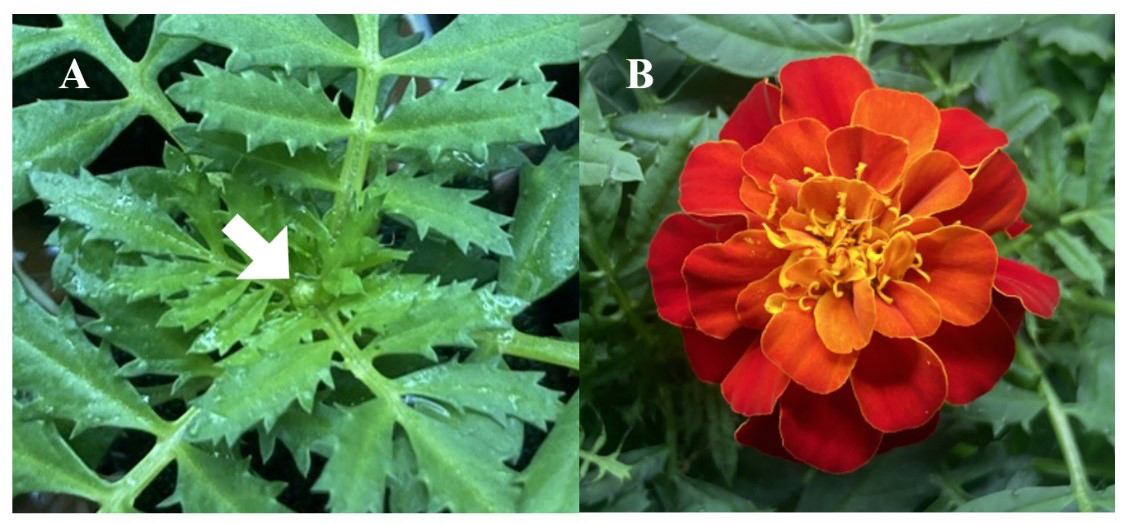
-
The Optimum Photoperiod on Floral Differentiation of French Marigold Grown in a Closed-type Plant Factory
완전제어형 식물공장에서 재배되는 프렌치매리골드의 화아분화를 위한 최적의 광주기 구명
-
Nayoung Kwak, Bo Hyun Sung, K.P.S. Kumaratenna, Young-Yeol Cho
곽나영, 성보현, 피우미 사우미야 쿠마라테나, 조영열
- Among the various environmental conditions necessary for growing crops, light is closely related to the anthesis. This study aimed to determine the …
작물을 재배하는 데 필요한 여러 가지 환경 조건 중 광은 개화와 밀접한 연관이 있다. 본 연구는 식용화, 매리골드 화아분화에 영향을 주는 최적의 …
- Among the various environmental conditions necessary for growing crops, light is closely related to the anthesis. This study aimed to determine the optimal photoperiod affecting floral differentiation in an edible flower, marigold, to efficiently cultivate the crops in a closed-type plant factory. The experiment was conducted with photoperiods of 4, 8, 12, and 16 hours. French marigold (Tagetes patula L.) ‘Durango Red’ seeds were sown in polyurethane sponges, and the photoperiod treatments were applied immediately. The extent of floral differentiation was examined at 2-3 day intervals, defined as the visible appearance of flower buds at least 2 mm in size. The growth parameters such as shoot fresh weight and dry weight, height, and leaf area were measured. The optimal photoperiod was determined based on the days when the floral differentiation had occurred in 50% of the total plants. In the 4-hour treatment, proper growth and flower buds did not appear. From the 8-hour treatment, the plant grew normally, and floral differentiation occurred, however, the 8-hour treatment showed the slowest floral differentiation compared to the 12 hours treatments or more. The 12- and 16-hour treatments didn’t show significant differences in floral differentiation. While the 16-hour treatment exhibited the highest results in all growth parameters, it was not significantly different from the 12-hour treatment except for shoot dry weight and leaf area. According to the results, 8 hours of photoperiod induced floral differentiation. However, more time was required for flower bud formation, and plant growth was significantly lower compared to photoperiods of 12 hours or more. Considering the energy consumption and its growth, the optimal photoperiod for marigold was 12 hours.
- COLLAPSE
작물을 재배하는 데 필요한 여러 가지 환경 조건 중 광은 개화와 밀접한 연관이 있다. 본 연구는 식용화, 매리골드 화아분화에 영향을 주는 최적의 광주기를 구명하여 완전제어형 식물공장에서 효율적으로 재배하기 위해 진행되었다. 실험에 사용된 광주기는 4, 8, 12, 16시간, 총 4가지로 설정하였다. 매리골드 ‘듀란고 레드’ 종자를 우레탄 스펀지에 파종한 직후부터 광주기를 처리하였다. 화아분화는 꽃봉오리가 약 2mm 이상일 때 화아분화가 되었다고 정의하였고, 2-3일 간격으로 조사하였다. 생육 조사는 지상부의 생체중, 건물중, 초장, 엽면적을 조사하였다. 최적의 광주기는 식물체의 50%가 화아분화 된 날을 기준으로 정의하였다. 4시간 처리구에서는 식물체가 제대로 자라지 못하며 화아도 형성되지 않았다. 8시간 이상의 처리구에서부터 식물체가 정상적으로 생장하고 화아분화가 이루어졌지만, 8시간 처리구는 12시간 이상의 처리구에 비해 화아분화가 더디게 일어났다. 반면에 12시간 처리구와 16시간 처리구는 서로 유의하지 않은 결과를 보였다. 모든 생육조사 항목에서 16시간 광주기 처리구가 가장 높은 값을 나타냈으나 지상부의 건물중과 엽면적을 제외한 나머지 항목에서 12시간 처리구와 유의하지 않았다. 실험 결과에 따르면, 8시간 광주기에서도 화아분화가 일어났지만, 화아형성까지의 시간이 12시간 이상의 광주기일 때보다 더 많이 소요되었으며, 식물체의 생육 또한 12시간 이상의 광주기를 조사받은 식물체보다 낮게 나타났다. 본 실험에서 에너지 소비량을 고려한 최적의 매리골드 ‘듀란고 레드’의 광주기는 12시간으로 판단된다.
-
The Optimum Photoperiod on Floral Differentiation of French Marigold Grown in a Closed-type Plant Factory
Journal Informaiton
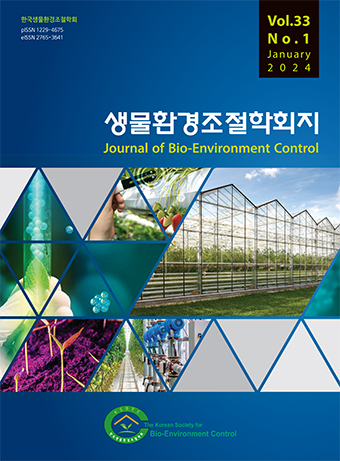 Journal of Bio-Environment Control
Journal of Bio-Environment Control
Journal Informaiton
Journal Informaiton - close
 Journal of Bio-Environment Control
Journal of Bio-Environment Control







